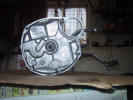
Four view of the gear box. Front showing the splined
clutch shaft in the middle... |
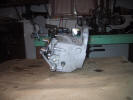
...right side showing reverse/neutral shift lever and
neutral switch. |
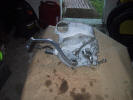
The rear of the box showing the kick start lever,
clutch release arm and flexible coupling plate (yoke) on the main
shaft... |
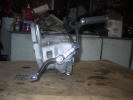
...and finally the left side of the box with the foot
shift lever. On top is the vent screw, underneath that, the
filler cap can be seen for the oil and below the drain plug. |
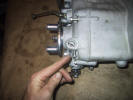
Start the disassembly by removing the speedometer
gear. Back out the speedo cable retaining screw by hand or use a
10mm wrench. |
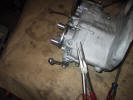
Use a long pair of needle nose pliers to... |
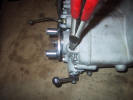
...reach down in and spread the pliers apart... |
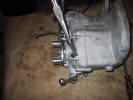
...and carefully lift out the speedo drive gear. You
may need to turn the flexible coupling plate slightly to disengage
the gears. |
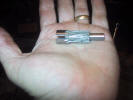
Speedo drive gear removed. Place it in a parts box so
it will not get lost of damaged. |
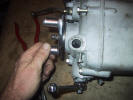
You can just barely see the drive gears of the
flexible coupling plate, these are what engage and turn the speedo
drive gear. |
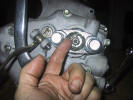
To remove the flexible coupling plate, this cotter
pin must be removed. |
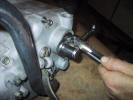
Use a pair of pliers or cutters to bend the cotter
arms straight and then... |
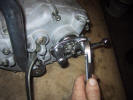
...pull the cotter pin out. |
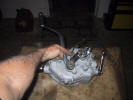
If the box is in neutral, block the fork with a
socket or wood between the kick starter arm to keep the coupling
plate and main shaft from turning. |
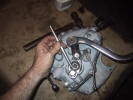
Use a 22mm socket to loosen and remove the nut and
washer underneath. If a socket will not fit, use a tommy bar and
hammer on the flats of the nut. |
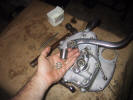
22mm retaining nut removed. |
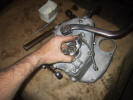
The coupling plate just slips off the splines of the
main shaft... |
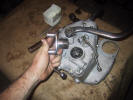
...like so. Careful that the washer under the nut
does not fall and get lost. |
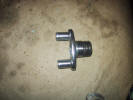
A closer view showing the gearing on the end of the
flexible coupling plate to drive the speedo gear. |
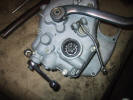
A view down the main shaft hole showing the #304 ball
bearing on the aft end of the main shaft. |
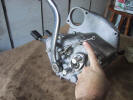
Remove the clutch release arm next. |
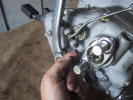
Use your fingers to squeeze the cotter pin of the
clutch lever pin together... |
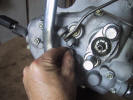
...grasp the head of the cotter pin... |
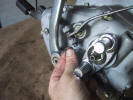
...and pull it free. |
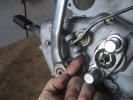
Use your finger to push the clutch lever pin up... |
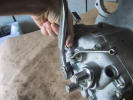
...and pull it free while holding the clutch lever
arm. For further disassembly of the clutch rod assembly refer to
Chapter 6.3. |
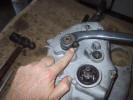
To remove the kick start lever start by... |
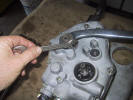
...using a 13mm wrench to remove... |
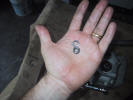
...the retaining nut and washer. |
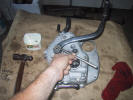
Use a drift or tommy bar and hammer to drive the kick
starter lever wedge pin out. |
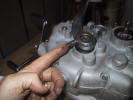
Make a note of the orientation of the "flat" on the
wedge pin.
|
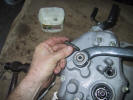
Remove the wedge pin and place it in a parts box. |
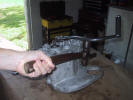
Use a hammer to tap the kick start lever...
|
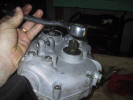
...off the kick starter shaft. |

Note how the flat of the wedge pin seats in the
groove of the kick starter shaft. |
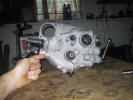
Next remove the 7 10mm bolts that hold the two halves
of the gear box case together. |

Use a ratchet or wrench whichever is handy. |
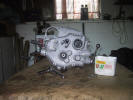
The gear box is now ready to be split. |
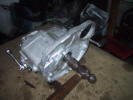
Use a soft face hammer to smack the end of the clutch
shaft repeatedly... |
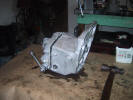
...until the halves separate. |
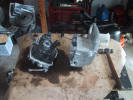
A rap or two more with the hammer and a little
jiggling and the halves will separate. |
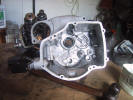
A view of the inside of the front case. Lower left is
the foot shift lever. Upper right is the shift quadrant latch
assembly. |
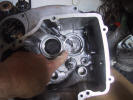
If it/they did not fall out when splitting the case;
look here for... |
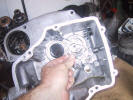
...the main shaft adjustment shims. They are very
thin and easily damaged so be careful and put them somewhere safe. |
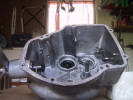
In the top center of the front cover you will see the
oil chute which channels oil to the the front bearing of the main
shaft. |
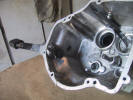
A better view of the gear shift foot pedal shaft. |
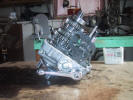
A right side view of the back half of the case
showing the shift quadrants and gear tower. |
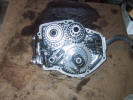
Overhead view of the inside of case. From the upper
left clockwise; Main shaft bearing and gears, clutch shaft bearing
and gears, gear shift assembly, Kick start shaft and gear, idler
bracket and gear and the normal and reverse gear shift quadrants. |
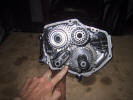
To begin removing the gear box shafts, start by
removing the lock washer and 12mm retaining bolt for the idler gear
assembly. |
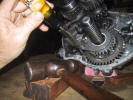
Use a wood chisel or similar tool and hammer to bend
the locking tab out... |
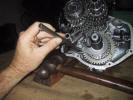
...and tap it flat with a tommy bar. |
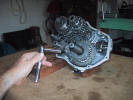
Use a 12mm socket or wrench to loosen and ... |
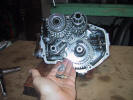
Remove the bolt and lock washer. |
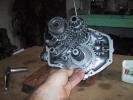
The reverse shift fork will now be free... |

...and can simply be pulled out. |
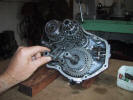
Pull the idle assembly shaft... |
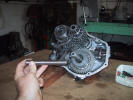
...free of the idler bracket. |
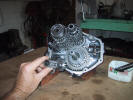
The idler bracket with idler gear can now be removed. |
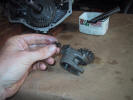
Be careful to not drop/lose the idler pin from the
bracket assembly. |
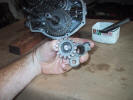
The idler gear is a fixed to the bracket by a large
rivet. |
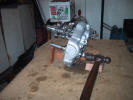
Use a hammer to tap the kick starter shaft free of
the rear housing. |
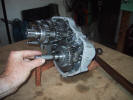
A few gentle taps... |
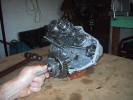
and the kick starter shaft easily pulls free. |
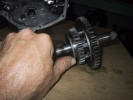
A nice view showing the reverse gear (small gears
with fingers) and kick starter gear. |
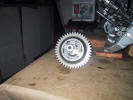
A back view of the kick start shaft/gear showing the
engagement holes for the fingers of the reverse gear and the pawl
mechanism for the kick starter return. |
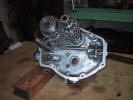
A view of the case sans kick start shaft. |
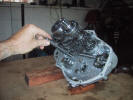
Now grasp the shift fork shaft... |
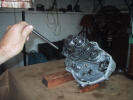
...and pull it free. Use care as the shift forks may
fall free. |
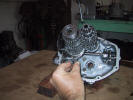
Rotate the 3rd/4th gear shift fork slightly CCW and
pull down to remove. |
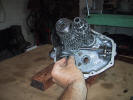
Do the same for the 1st/2nd shift fork. |
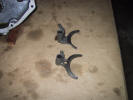
Forks removed. |
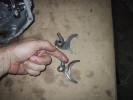
Note the burned and scored area where the 3rd/4th
gear fork was rubbing against the 3rd/4th gear shift sleeve. |
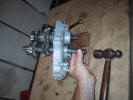
Use a 12mm socket or similar tool to drive the clutch
shaft out of its bearing. Make sure the clutch gear teeth are in
mesh with the main gear teeth before striking with hammer. |
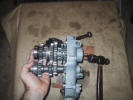
The clutch shaft may not come free due to clearance
of the bearing on the end of its shaft. Either way, remove the main
shaft and gears by tapping with a hammer on the exposed end of the
shaft where the flexible coupling was mounted. |
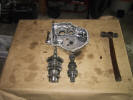
The main shaft and clutch shaft free of the housing. |

On the aft end of the clutch shaft is the #12204
roller bearing (I am pointing to), The race for this bearing will
remain in the case. To remove the race you will need an inside type
bearing puller. There are grooves in the case at 12 and 6 o'clock
around the race for the puller arms to grab. A #205 bearing is on
the front. Either can be removed with a bearing separator. The 4th
gear of the clutch shaft (behind #205 bearing on the left) is the
only gear that can be replaced on the clutch shaft. It is keyed onto
the shaft. |
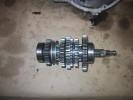
Profile view of the main shaft, bearings and gears.
Disassembly and description shown below. |
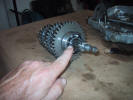
You may find what appears to be an "odd" seal on the
face of the bearing on the aft of the main shaft. This is actually
RTV sealant that the factory uses in an attempt to prevent oil from
migrating down the splines between the shaft and flexible coupling;
and then getting flung off the driveshaft onto your right leg and
side of hack. |
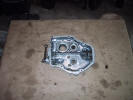
Rear case with all 3 shafts removed. Just to the left
of the kick start shaft hole are the 2 pins that the ratchet pawl on
the back of the kick start gear locks into.
All that remains to be removed is the gear shift
mechanism and reverse/neutral shift lever mechanism. Since I do not
need to remove these items, I will just describe the procedure for
their removal. If you have got this far...the rest is a piece of
cake. |
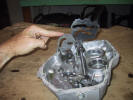
Here is the reverse shift quadrant... |
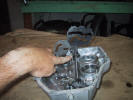
...this is the stop screw for the reverse quadrant. |
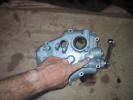
This is the head of the reverse stop screw and lock
nut. |
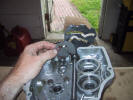
When the reverse lever is engaged, the quadrant moves
aft to the stop screw... |
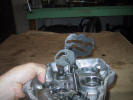
...you can see a pin from the shift quadrant resting
in the guide slot of the reverse quadrant. This is to lock out the
shift quadrant while in reverse. This way you can not inadvertently
engage a forward gear. |
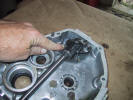
This is the upper foot shift adjustment screw. It
adjusts downshifting. If you are going to remove the foot shift
ratchet mechanism and shaft, you will need to remove it along
with... |
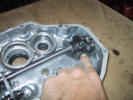
...the up shift adjustment screw. |
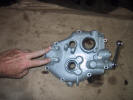
Here are the two adjustment screws and lock nut on
the back of the case. |
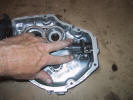
Then you will need to cut the safety wire and remove
both the 10mm bolts securing the shift ratchet mechanism to the
case. |
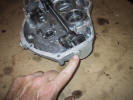
The bolt for the shift ratchet mechanism return
spring will need to be removed next. |

Then the 4 screws hold the right side cover of the
shift quadrant shaft will need to be removed. Remove the stop pin
from the gear shift shaft. The gear shift
mechanism can now be removed for repair. |
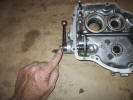
All that is left is to remove the reverse/neutral
lever and quadrant. Use a 13mm wrench to remove the retaining nut of
the lever. Mark the position of the lever on
the shaft before removing. The lever and shaft end are
splined and may require slight prying/pulling to remove the lever.
Once the lever is removed, the reverse quadrant and shaft can be
pulled free of the case. |
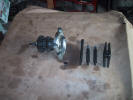
To remove the gears from the main shaft you will need
a bearing separator to remove the bearing at each end of the shaft.
Place the separator behind the bearing you wish to
remove and tighten the separator in place.
|
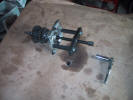
Attach the extension arms and puller screw, use an
appropriate wrench to turn the puller screw.... |
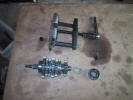
Until the bearing is pulled off. To the left of the
bearing is main shaft washer which is under the bearing.
!Caution!
When the forward bearing (pictured
above) is removed; 2nd through 4th gears and sleeves are free to
slide off the main shaft onto the floor.
When the aft bearing is removed;
1st gear is free to the same. |
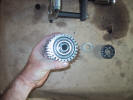
A view down the shaft looking at the 4th gear riding
a top the main shaft sleeve.
|
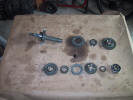
From right to left, bottom to top;
Bottom row: #304 bearing, main shaft washer, 4th
gear, 3rd/4th shift sleeve, main shaft sleeve, and 3rd gear.
Top row: 2nd gear, main shaft sleeve, 1st/2nd
shift sleeve (reverse also), main shaft with 1st gear and #304
bearing. |
To remove 1st gear,
use bearing separator to pull #304 bearing and gear will slide off.
Reassembly for main shaft is reverse of disassembly.
|
|
|
|